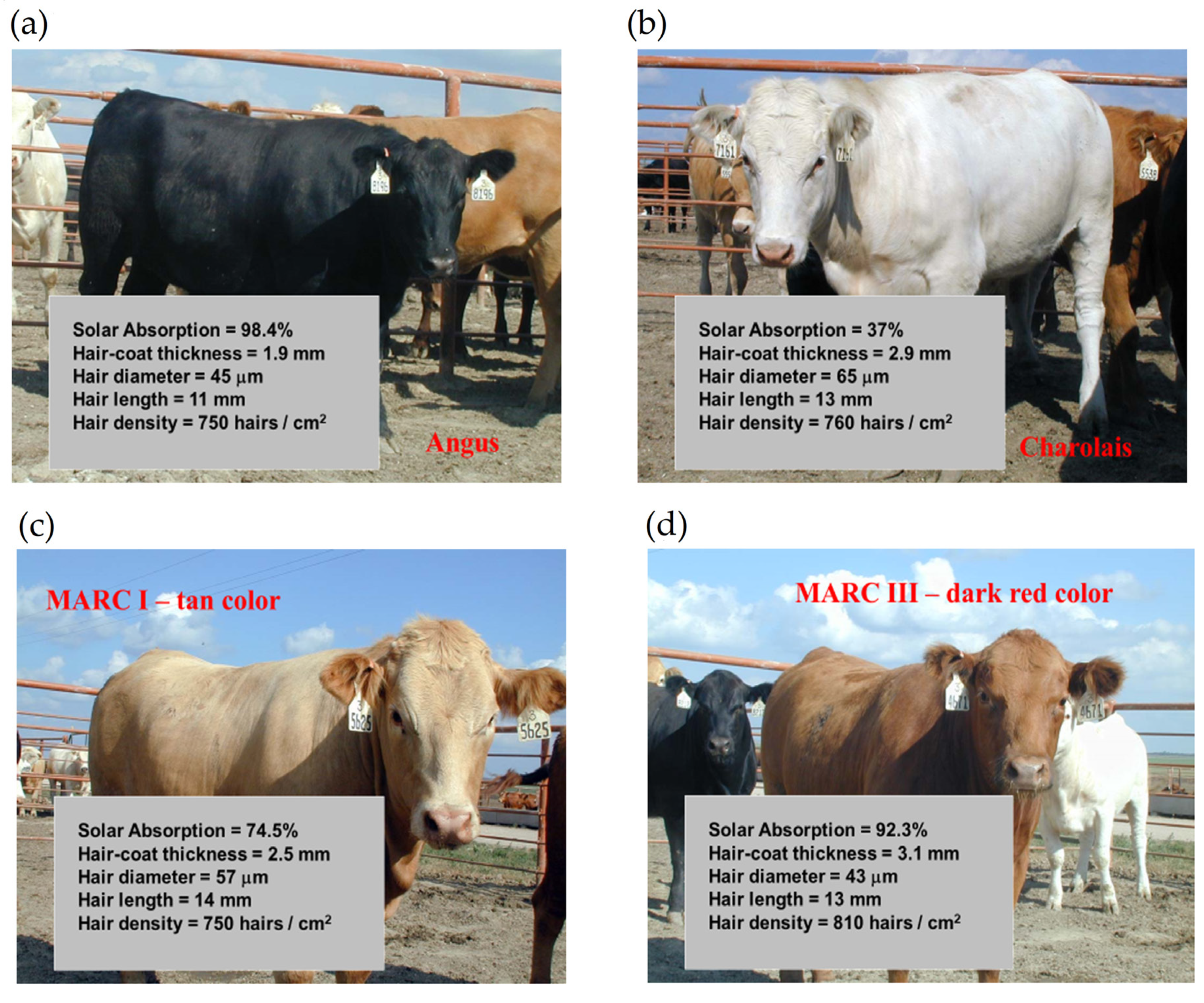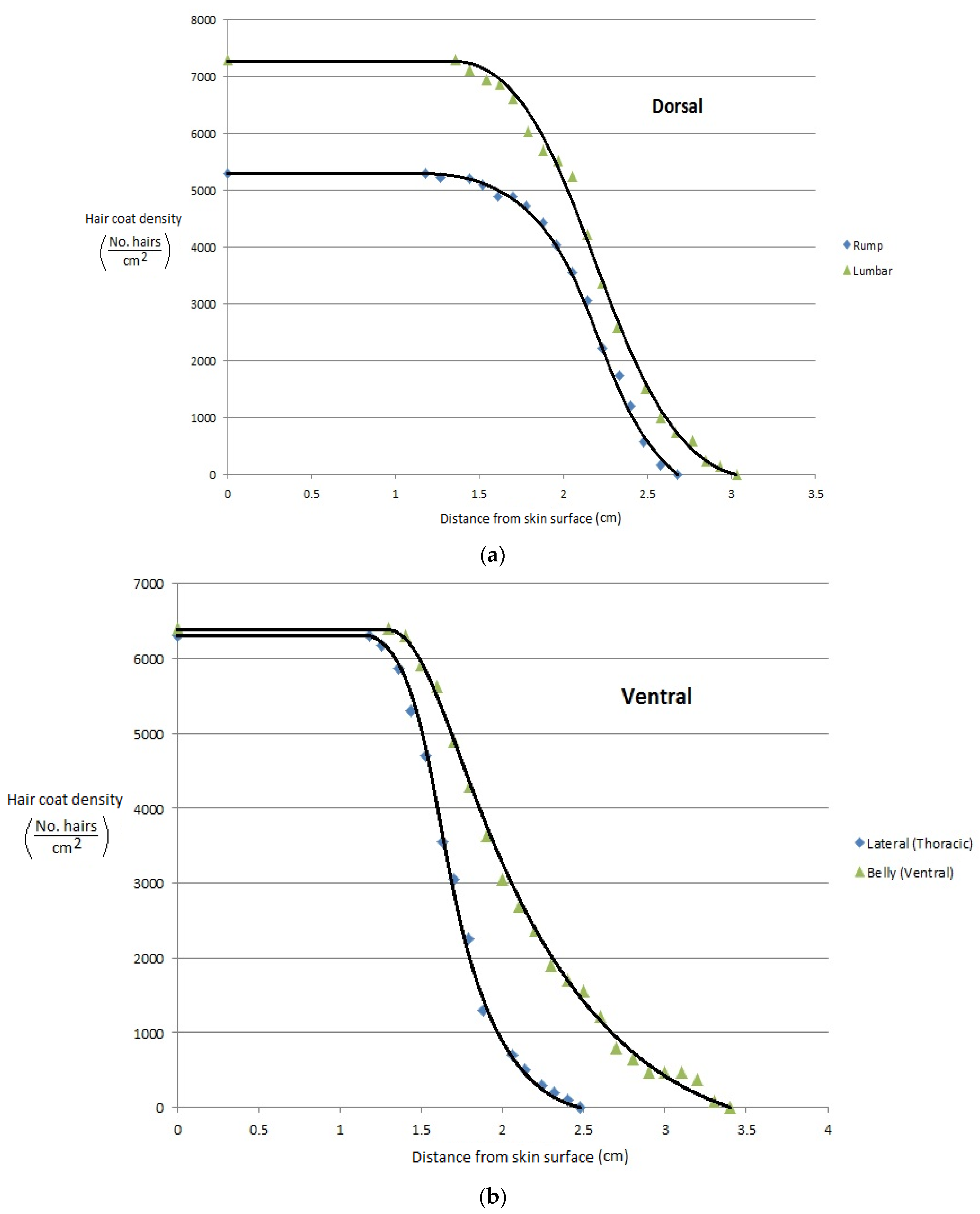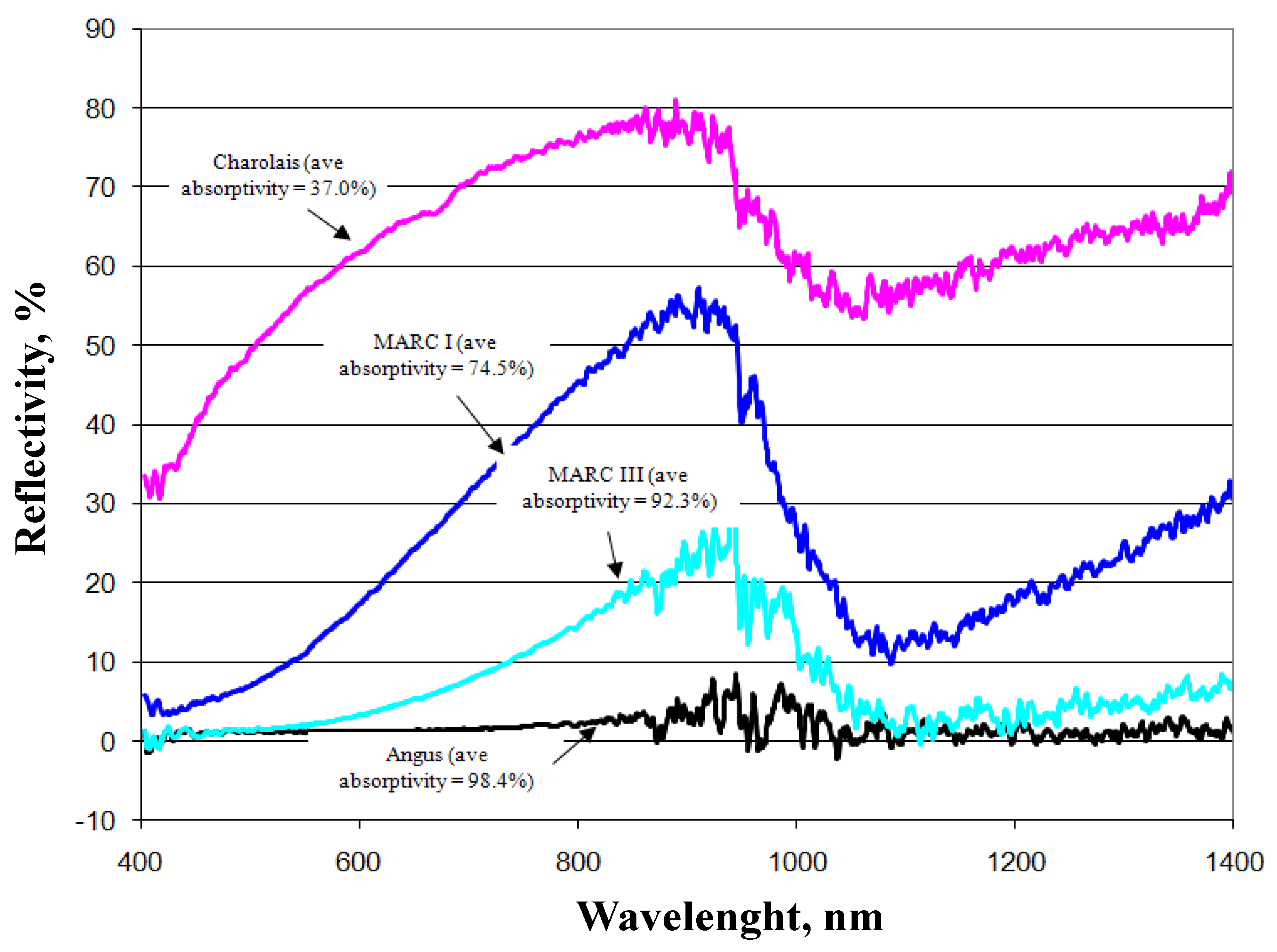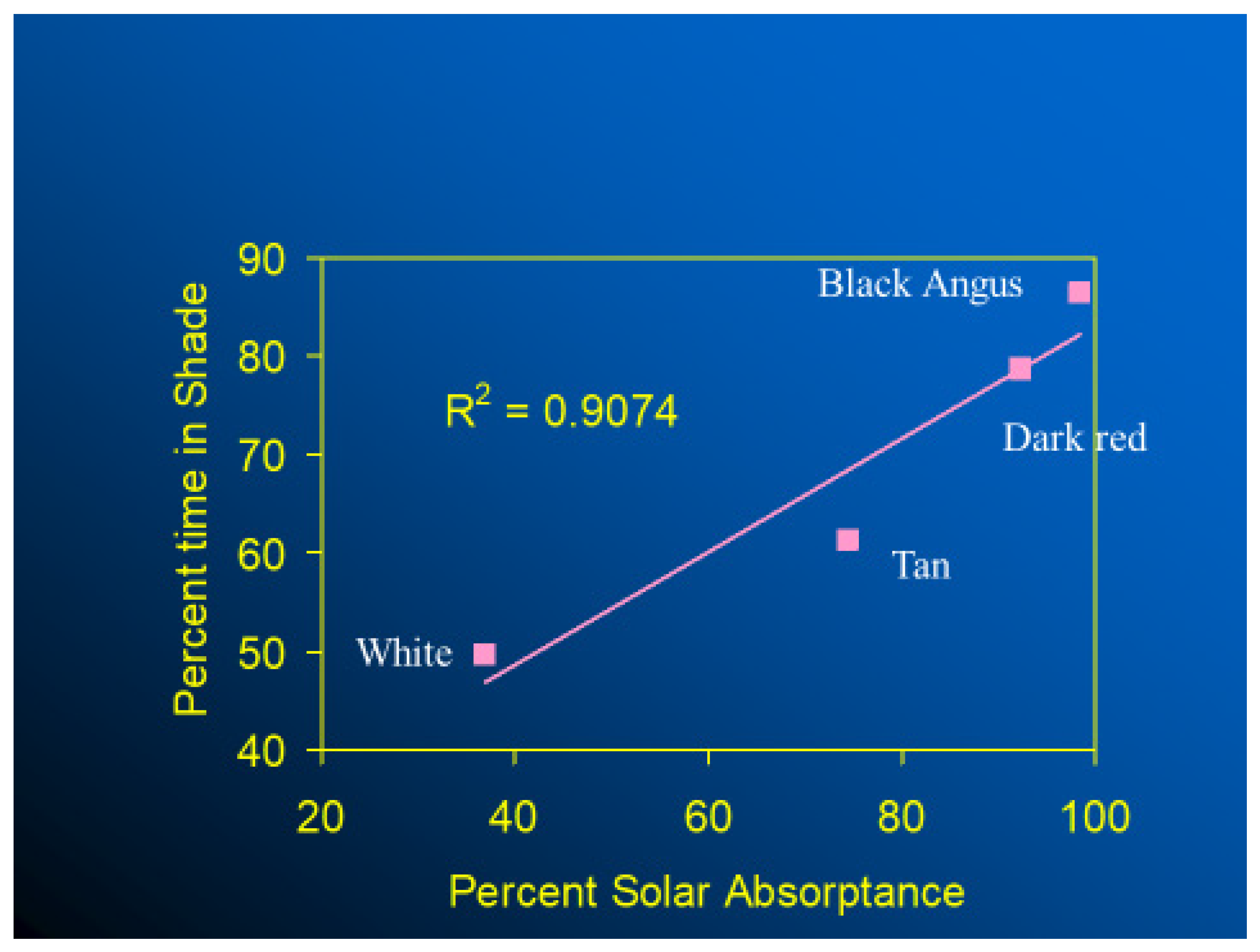Methods, Thermodynamic Applications, and Habitat Implications of Physical and Spectral Properties of Hair and Haircoats in Cattle
Abstract
:Simple Summary
Abstract
1. Introduction
- (1)
- To compile physical and spectral properties’ data about hair and haircoats that represent present-day cattle that are available in the literature;
- (2)
- To identify methods and procedures for measuring hair and haircoat properties so that a common approach or standard could be followed for future research;
- (3)
- To show how the physical and spectral properties are applied in models of heat exchange between an animal and its surrounding environment, and their implications in behavioral thermoregulation of cattle.
2. Literature Review
2.1. Physical Properties of Haircoats
2.2. Spectral Properties of Haircoat
3. Measurement Procedures
3.1. Physical Properties
3.1.1. Haircoat Density
- Prepare samples from several locations (such as rump, lumbar, belly (ventral), thoracic (lateral), and head) of the animal;
- Cut hairs at ≤1 mm from the skin layer. Blow the shaved part with a stream of air jet to remove stray pieces of hairs. Clip all hairs from an area large enough to permit total counts of more than 20 squares on an ocular grid (e.g., 100 hairs/cm2);
- Adjust lighting to permit counting of individual hairs in stubble. Very intense light at nearly parallel to skin helps if skin and hairs are both black;
- Count hairs on a random number chart built into the ocular grid;
- Calibrate the ocular grid using a stage micrometer or using a good ruler.
3.1.2. Hair Diameter
- Clip off hairs at ≤1 mm from the skin layers with aris scissors and put the hairs in a microscope slide with dissecting forceps. Apply a drop of water on the slide to pressure the hairs;
- Separate individual hairs in rows;
- Measure diameters under the calibrated ocular micrometer.
3.1.3. Haircoat Depth
3.1.4. Hair Length
- Under a dissecting microscope, clip hairs at less than 1 mm from the skin surface with an iris scissor or equivalent;
- The hair will stick to the scissor. Put the scissor tip with hairs on it in a drop of soap and water or “Tame” cream rinse, which is on a microscope slide. The soap may be any liquid type that will act as a wetting agent. Do not put more than 20 hairs on a slide. Separate the hairs by spreading them around and put them in rows so that they will be traceable individually;
- Cover the hairs with cover slip and seal layers with Permount (mounting medium) to keep the water from evaporating (water is to preserve the hairs);
- Measure the length of the hair with a camera lucida and a map-measuring device. The map-measuring device should be calibrated under the camera lucida using a ruler. Hair length is measured by tracing the image with the map-measuring device. A total sample size of about 200 hairs may be needed for a given body location.
3.2. Spectral Properties of Haircoat
3.2.1. Transmissivity and Reflectivity
3.2.2. Absorptivity
4. Applications of Hair and Haircoat Properties in Thermodynamic Models
5. Habitat Implicatons of Hair and Haircoat Physical and Spectral Properties
6. Concluding Thoughts
- Data and procedures for measuring and recording physical (hair length, diameter, haircoat thickness and density) and spectral (reflectivity, absorptivity and transmissivity) properties of hair and haircoats of cattle are identified. These properties are inputs to models of thermoregulation of cattle;
- The physical properties of hair and haircoats are not numerically the same at different locations (dorsal, ventral, lateral, neck, head, etc.) of the body of a cow. The density (no. of hairs/cm2) of a haircoat is not constant throughout the depth of the haircoat. It is expressed by a hyperbolic tangent function. The average solar absorptivity of the haircoat of four breeds of cows were black = 98%, dark red = 92%, Tan = 75%, and white = 37%;
- The effective thermal conductivity of a haircoat increases with hair density and hair diameter. A less dense haircoat presents lower effective transmissivity regardless of the color of the haircoat;
- The effective absorptivity is greater in cattle with black and dense coats with long and thick hairs than that in white and less dense coats with short and thin hairs. Despite having a higher absorptivity of solar radiation, Holstein cows with predominantly black haircoats are more suitable in latitudes of high solar radiation than those with white haircoats;
- In hot climates, a black haircoat acts as a solar shield because the peak temperature in the haircoat is close to the haircoat–air interface (away from the skin) where convection heat loss is high because of the wind effect, whereas a white haircoat is more transparent and thus allows solar energy to penetrate deep into the haircoat, thus causing heat to flow toward the skin surface (heat gain);
- Animal haircoats trap air to provide insulation and thus conserve body heat (essential during cold weather) but become an obstruction for evaporative cooling from the skin surface by reducing the velocity and moisture gradients through the fur layer in hot and humid conditions;
- The physical and spectral properties of hair and haircoats lead to important thermoregulatory behavior, such as seeking and staying in shade when thermally stressed. Cattle with black haircoats spend more time using shade than those with white and red haircoats.
Author Contributions
Funding
Institutional Review Board Statement
Informed Consent Statement
Data Availability Statement
Conflicts of Interest
References
- Da Silva, R.G.; La Scala, N., Jr.; Pocay, P.L. Transmission of ultraviolet radiation through the haircoat and skin of cattle. Braz. J. Anim. Sci. 2001, 30, 1939–1947. [Google Scholar]
- Gebremedhin, K.G. Heat Stress and Evaporative Cooling. In Environmental Physiology of Livestock; Collier, R.J., Collier, J.L., Eds.; John Wiley Sons: Chicehster, UK, 2012; pp. 35–48. [Google Scholar]
- Bertipaglia, E.C.A.; da Silva, R.G.; Maia, A.S.C. Fertility and hair coat characteristics of Holstein cows in a tropical environment. Anim. Reprod. 2005, 2, 187–194. [Google Scholar]
- DeMelo Costa, C.C.; Maia, A.S.C.; Nascimento, S.T.; Nascimento, C.C.N.; Fonseca, V.F.C. Thermal balance of Nellore cattle. Int. J. Biometeorol. 2018, 62, 723–731. [Google Scholar] [CrossRef] [PubMed]
- Berman, A.; Volcani, R. Seasonal and regional variations in coat characteristics of dairy cattle. Aust. J. Agric. Res. 1961, 12, 528–538. [Google Scholar] [CrossRef]
- Bertipaglia, E.C.A.; Rda Silva, G.; Cardoso, V.; Fries, L.A. Hair-coat characteristics and sweating rate of Bradford cows in Brazil. Livest. Sci. 2007, 112, 99–108. [Google Scholar] [CrossRef]
- Da Silva, R.G.; Maia, A.S.C.; Costa LL, M.; Queiroz, J.P. Latent heat loss of dairy cows in an equatorial semi-arid environment. Int. J. Biometeorol. 2012, 56, 927–932. [Google Scholar] [CrossRef]
- Collier, R.J.; Gebremedhin, K.G. Thermal biology of domestic animals. Annu. Rev. Anim. Biosci. 2015, 3, 513–532. [Google Scholar] [CrossRef]
- Hutchinson, J.; Brown, G. Penetrance of cattle coats by radiation. J. Appl. Physiol. 1969, 26, 454–463. [Google Scholar] [CrossRef]
- Peters, H.F.; Slen, S.B. Hair Coat Characteristics of Bison, Domestic X Bison Hybrids, Cattalo, and Certain Domestic Breeds of Beef Cattle. Can. J. Anim. Sci. 1968, 44, 48–57. [Google Scholar] [CrossRef]
- Gebremedhin, K.G.; Lee, C.N.; Hillman, P.E.; Brown-Brandl, T.M. Body temperature and behavioral activities of four breeds of heifers in shade and full sun. Am. Soc. Agric. Biol. Eng. 2011, 27, 999–1006. [Google Scholar] [CrossRef]
- Gebremedhin, K.G.; Porter, W.P.; Warner, R.G. Heat flow through pelage of calves—A sensitivity analysis. Am. Soc. Agric. Eng. 1984, 27, 1140–1143. [Google Scholar] [CrossRef]
- Verissimo, C.J.; Nicolau, C.V.J.; Cardoso, V.L.; Pinheiro, M.G. Hair-coat Characteristics and Tick Infestation on GYR(Zebu) and Crossbred (Holstein x GYR) Cattle. Arch. Zootec. 2002, 51, 389–392. [Google Scholar]
- Da Silva, R.G.; La Scala, N., Jr.; Tonhati, H. Radiative properties of the skin and hair coat of cattle and other animals. Am. Soc. Agric. Biol. Eng. 2003, 46, 913–918. [Google Scholar]
- Maia, A.S.C.; da Silva, R.G.; Bertipaglia, E.C.A. Hair coat traits in Holstein cows in tropical environments: A genetic and adaptive study. Braz J. Anim. Sci. 2003, 32, 843–853. [Google Scholar]
- Gilbert, R.P.; Bailey, D.R.C. Hair Coat Characteristics and Postweaning Growth of Hereford and Angus Cattle. J. Anim. Sci. 1991, 69, 498–506. [Google Scholar] [CrossRef] [PubMed]
- Ibelli, A.M.; Ribeiro, A.R.; Giglioti, R.; Regitano, L.D.; Alencar, M.M.; Chagas, A.D.; Paço, A.L.; Oliveira, H.N.; Duarte, J.M.; Oliveira, M.D. Resistance of cattle of various genetic groups to the tick Rhipicephalus microplus and the relationship with coat traits. Veterinary Parasitology. Vet. Parasitol. 2012, 186, 425–430. [Google Scholar] [CrossRef]
- Marufu, M.C.; Qokweni, L.; Chimonyo, M.; Dzama, K. Relationship between tick counts and coat characteristics in Nguni and Bonsmara cattle reared on semiarid rangelands in South Africa. Tick Tick-Bone Dis. 2011, 2, 172–177. [Google Scholar] [CrossRef]
- Shyma, K.P.; Gupta, J.P.; Singh, V. Breeding strategies for tick resistance in tropical cattle: A sustainable approach for tick control. J. Parasit. Dis. 2015, 39, 1–6. [Google Scholar] [CrossRef]
- Feltes, G.L.; Michelotti, V.T.; Prestes, A.M.; Rorato, P.R.N.; Mello, F.C.B.; Oliveira, M.M.; Roso, V.M. Genetic and environmental factors that affect tick infestation in Nelore x Angus crossbreed cattle. Ciência Rural. 2021, 51, 1–8. [Google Scholar] [CrossRef]
- Hillman, P.E.; Lee, C.N.; Carpenter, J.R.; Baek, K.S.; Parkhurst, A. Impact of Hair Color on Thermoregulation of Dairy Cows to Direct Sunlight; Paper No. 014031; American Society of Agriculture and Biological Engineers: St. Joseph, MI, USA, 2001. [Google Scholar]
- Maia, A.S.C.; da Silva, R.G.; Bertipaglia, E.C.A. Environmental and genetic variation of the effective radiative properties of the coat of Holstein cows under tropical conditions. Livest. Prod. Sci. 2005, 92, 307–315. [Google Scholar] [CrossRef]
- Fonsêca, V.F.C. 2023. Unpublished data.
- Cena, K.; Monteith, J.L. Transfer processes in animal coats. Proc. R. Soc. 1975, 188, 377–393. [Google Scholar]
- Gebremedhin, K.G.; Wu, B.X. Characterization of flow field in a ventilated space and simulation of heat exchange between cows and their environment. J. Therm. Biol. 2003, 28, 301–319. [Google Scholar] [CrossRef]
- Siegel, R.; Howell, J.R. Thermal Radiation Heat Transfer; McGraw-Hill: New York, NY, USA, 1972. [Google Scholar]
- Kowalski, G.J. An Analytical and Experimental Investigation of the Heat Mechanism within Fibrous Media; American Society of Mechanical Engineers: New York, NY, USA, 1978; pp. 1–7. [Google Scholar]
- Gebremedhin, K.G. A model of sensible heat transfer across the boundary layer of animal hair coat. J. Therm. Biol. 1987, 12, 1–10. [Google Scholar] [CrossRef]
- Gebremedhin, K.G.; Porter, W.P.; Cramer, C.O. Quantitative Analysis of the Heat Exchange through the Fur Layer of Holstein Calves. ASAE 1983, 26, 188–193. [Google Scholar] [CrossRef]
- Gebremedhin, K.G.; Wu, B. A model of evaporative cooling of wet skin surface and fur layer. J. Therm. Biol. 2001, 26, 537–545. [Google Scholar] [CrossRef]
- Berman, A. Tissue and external insulation estimates and their effects on prediction of energy requirements and of heat stress. J. Dairy Sci. 2004, 87, 1400–1412. [Google Scholar] [CrossRef]
- McArthur, A.J. Thermal interaction between animal and microclimate: A comprehensive model. J. Therm. Biol. 1987, 126, 203–238. [Google Scholar] [CrossRef]
- Turnpenny, J.R.; Wathes, C.M.; Clark, J.A.; Mcarthur, A.J. Thermal balance of livestock: II. Applications of a parsimonious model. Agric. For. Meteorol. 2000, 101, 29–52. [Google Scholar] [CrossRef]
- Katiyatiya, C.L.F.; Muchenje, V. Hair coat characteristics and thermophysiological stress response of Nguni and Boran cows raised under hot environmental conditions. Int. J. Biometeorol. 2017, 61, 2183–2194. [Google Scholar] [CrossRef]
- Dikmen, S.; Alava, E.; Pontes, E.; Fear, J.M.; Dikmen, B.Y.; Olson, T.A.; Hansen, P.J. Differences in thermoregulatory ability between slick-haired and wild-type lactating Holstein cows in response to acute heat stress. J. Dairy Sci. 2008, 91, 3395–3402. [Google Scholar] [CrossRef]
- Scharf, B.; Wax, L.E.; Aiken, G.E.; Spiers, D.E. Regional differences in sweat rate response of steers to short-term heat stress. Int. J. Biometeorol. 2008, 52, 725–732. [Google Scholar] [CrossRef]
- Finch, V.A.; Dmi’el, R.; Boxman, R.; Shkolnik, A.; Taylor, R. Why black goats in hot deserts? Effects of coat color on heat exchanges of wild and domestic goats. Physiol. Zool. 1980, 53, 19–25. [Google Scholar] [CrossRef]
- Shkolnik, A.; Taylor, R.; Finch, V.; Borut, A. Why do Bedouins wear black robes in hot deserts? Nature 1980, 283, 373–375. [Google Scholar] [CrossRef]
- Finch, V.A.; Bennet, I.L.; Holmes, C.R. Coat colour in cattle: Effect on thermal balance, behaviour and growth, and relationship with coat type. J. Agric. Sci. 1984, 102, 141–147. [Google Scholar] [CrossRef]
- Silva, W.C.S.; Silva, E.B.R.; Santos, M.R.P.; Camargo Junior, R.N.; Barbosa, A.V.; Vinhote, J.A.; Loureço Júnior, J.B. Behavior and thermal Comfort of light and dark coat dairy cows in the Eastern Amazon. Front. Vet. Sci. 2022, 9, 1–15. [Google Scholar] [CrossRef]
- DaSilva, R.G.; Guilhermino, M.M.; Morais, D.A.E.F. Thermal radiation absorbed by dairy cows in pasture. Int. J. Biometeorol. 2010, 54, 5–11. [Google Scholar] [CrossRef]
- Hansen, P.J. Effects of coat colour on physiological responses to solar radiation in Holsteins. VetRecord 1990, 127, 333–334. [Google Scholar]
- Berman, A. Invited review: Are adaptations present to support dairy cattle productivity in warm climates? J. Dairy Sci. 2011, 77, 1–6. [Google Scholar] [CrossRef]
- Mitchel, D.; Snelling, E.P.; Hetem, R.S.; Maloney, S.K.; Strauss, W.M.; Fuller, A. Reviting concepts of thermal physiology: Predicting responses of mammals to climate change. J. Anim. Ecol. 2018, 87, 660–671. [Google Scholar] [CrossRef]
- Andersen, D.E. Genetic study of eye cancer in cattle. J. Hered. 1991, 82, 21–30. [Google Scholar] [CrossRef]
- Lee, C.N.; Baek, K.S.; Parkhurst, A. The impact of hair coat color on longevity of Holstein cows in the tropics. J. Anim. Sci. Technol. 2016, 10, 41–58. [Google Scholar] [CrossRef] [PubMed]
- Morais, D.A.E.F. Variation in the Coat Characteristics, Thyroid Hormone Levels and Milk Yield of Dairy Cows in a Hot, Dry Environment. Ph.D. Thesis, Universidade Estadual Paulista, Jaboticabal, SP, Brazil, 2002; 121p. [Google Scholar]











| Breed | Hair Length (mm) | Hair Diameter (μm) | Haircoat Density (#/cm2) | Haircoat Depth (mm) | Study Location | Comments |
|---|---|---|---|---|---|---|
| 1 Holstein (Rump) | 21.62 ± 2.93 (85) | 48.80 ± 9.09 (21) | 5200 (at skin level) | 12.35 ± 1.29 (13) | USA (Wisconsin) | Winter |
| Holstein (Lumbar) | 22.05 ± 3.69 (86) | 54.97 ± 9.27 (19) | 7200 (at skin level) | 14.16 ± 1.08 (15) | USA (Wisconsin) | Winter |
| Holstein (Belly ventral) | 21.04 ± 5.02 (67) | 41.66 ± 10.75 (28) | 6300 (at skin level) | 15.28 ± 1.97 (15) | USA (Wisconsin) | Winter |
| Holstein (Thoracic lateral) | 17.13 ± 2.68 (62) | 41.73 ± 8.03 (26) | 6250 (at skin level) | 10.55 ± 1.41 (15) | USA (Wisconsin) | Winter |
| Holstein (Head) | 18.40 ± 3.12 (79) | 43.70 ± 7.30 (28) | 3900 (at skin level) | 12.56 ± 1.76 (15) | USA (Wisconsin) | Winter |
| Holstein (Grand total) | 20.05 ± 3.49 (399) | 46.375 ± 10.7 (245) | 3900–7200 (at skin level) | 12.98 ± 2.23 (73) | USA (Wisconsin) | Winter |
| 2 Holstein | 12.60 ± 3.45 | 62.49 ± 5.6 | 987.00 ± 347 | 2.48 ± 0.48 | Brazil | Tropical climate |
| 3 Braford | 10.41 ± 3.91 | 30.98 ± 8.13 | 993.18 ± 503 | 3.73 ± 1.72 | Brazil | Tropical climate |
| 4 Gyr (Zebu) | 4.68 ± 1.22 (15) | 1140.62 ± 289 (15) | 2.68 ± 0.34 (15) | Brazil | Tropical climate | |
| Zebu x 50–75% | 6.81 ± 1.81 (28) | 971.62 ± 292 (28) | 2.68 ± 0.47 (28) | Brazil | Tropical climate | |
| Holstein | ||||||
| Zebu x > 75% | 8.74 ± 2.22 (31) | 1071.90 ± 237 (31) | 2.95 ± 0.44 (31) | Brazil | Tropical climate | |
| Holstein | ||||||
| 5 Holstein | 11.1 | 40.1 | 1201 | 2.2 | Brazil | Tropical climate |
| Brangus | 20.8 | 41.2 | 867 | 2.4 | Brazil | Tropical climate |
| Nelore | 13.6 | 53.5 | 1944 | 3.2 | Brazil | Tropical climate |
| Simmental | 15.0 | 39.0 | 939 | 1.7 | Brazil | Tropical climate |
| Canchim | 17.1 | 47.0 | 1206 | 1.9 | Brazil | Tropical climate |
| Breed | Hair Color | Absorptivity | Reflectivity | Transmissivity | Study Location |
|---|---|---|---|---|---|
| 1 Angus | Black | 0.98 | USA | ||
| MARC III | Dark Red | 0.92 | USA | ||
| MARC I | Tan | 0.75 | USA | ||
| Charolaise | White | 0.37 | USA | ||
| 2 Holstein | Black | 0.89 ± 0.01 | USA | ||
| Holstein | White | 0.657 ± 0.045 | USA | ||
| 3 Holstein | Black * | 0.902 | 0.0893 | Brazil | |
| Holstein | White * | 0.518 | 0.4536 | Brazil | |
| 4 Holstein | Black | 0.93 | 0.06 | 0.01 | Brazil |
| Holstein | White | 0.43 | 0.53 | 0.04 | Brazil |
| Holstein | Red | 0.37 | 0.44 | 0.19 | Brazil |
| Brangus | Black | 0.92 | 0.07 | 0.01 | Brazil |
| Nelore | Dark Grey | 0.91 | 0.04 | 0.05 | Brazil |
| Simmental | Red | 0.54 | 0.29 | 0.17 | Brazil |
| Canchim | Gray | 0.27 | 0.66 | 0.07 | Brazil |
| Effects | n | l (mm) | L (mm) | ρh (Hair/cm2) | D (µm) |
|---|---|---|---|---|---|
| By month of sampling | |||||
| November | 771 | 2.56 ± 0.024 | 12.08 + 0.16 | 1062 ± 21 | 61.56 ± 0.27 |
| December | 454 | 2.50 ± 0.026 | 12.90 ± 0.18 | 1041 ± 23 | 62.41 ± 0.31 |
| January | 122 | 2.78 ± 0.046 | 13.82 ± 0.32 | 975 ± 41 | 61.07 ± 0.55 |
| February | 158 | 2.63 ± 0.036 | 12.35 ± 0.25 | 1222 ± 32 | 60.50 ± 0.43 |
| March | 332 | 2.56 ± 0.032 | 15.16 ± 0.22 | 1281 ± 28 | 59.53 ± 0.38 |
| April | 109 | 2.55 ± 0.051 | 17.98 ± 0.35 | 1070 ± 45 | 59.53 ± 0.60 |
| By cow age (years) | |||||
| <2 | 152 | 2.53 ± 0.074 | 14.27 ± 0.52 | 1316 ± 65 | 57.61 ± 0.88 |
| 2–3.5 | 684 | 2.55 ± 0.049 | 13.39 ± 0.34 | 1163 ± 43 | 59.75 ± 0.58 |
| 2.5–5 | 530 | 2.66 ± 0.043 | 14.14 ± 0.30 | 1060 ± 37 | 60.38 ± 0.51 |
| 5–6.5 | 301 | 2.78 ± 0.040 | 15.29 ± 0.28 | 1073 ± 35 | 60.39 ± 0.47 |
| 6.5–8 | 184 | 2.55 ± 0.052 | 13.78 ± 0.36 | 987 ± 46 | 62.20 ± 0.62 |
| >8 | 95 | 2.50 ± 0.075 | 13.42 ± 0.52 | 1056 ± 66 | 64.26 ± 0.89 |
| By coat color | |||||
| Black | 973 | 2.40 ± 0.024 | 12.97 ± 0.16 | 921 ± 21 | 62.40 ± 0.28 |
| White | 973 | 2.79 ± 0.024 | 15.13 ± 0.16 | 1296 ± 21 | 59.13 ± 0.28 |
Disclaimer/Publisher’s Note: The statements, opinions and data contained in all publications are solely those of the individual author(s) and contributor(s) and not of MDPI and/or the editor(s). MDPI and/or the editor(s) disclaim responsibility for any injury to people or property resulting from any ideas, methods, instructions or products referred to in the content. |
© 2023 by the authors. Licensee MDPI, Basel, Switzerland. This article is an open access article distributed under the terms and conditions of the Creative Commons Attribution (CC BY) license (https://creativecommons.org/licenses/by/4.0/).
Share and Cite
Gebremedhin, K.G.; Fonseca, V.D.F.C.; Maia, A.S.C. Methods, Thermodynamic Applications, and Habitat Implications of Physical and Spectral Properties of Hair and Haircoats in Cattle. Animals 2023, 13, 3087. https://doi.org/10.3390/ani13193087
Gebremedhin KG, Fonseca VDFC, Maia ASC. Methods, Thermodynamic Applications, and Habitat Implications of Physical and Spectral Properties of Hair and Haircoats in Cattle. Animals. 2023; 13(19):3087. https://doi.org/10.3390/ani13193087
Chicago/Turabian StyleGebremedhin, Kifle G., Vinicius D. F. C. Fonseca, and Alex S. C. Maia. 2023. "Methods, Thermodynamic Applications, and Habitat Implications of Physical and Spectral Properties of Hair and Haircoats in Cattle" Animals 13, no. 19: 3087. https://doi.org/10.3390/ani13193087
APA StyleGebremedhin, K. G., Fonseca, V. D. F. C., & Maia, A. S. C. (2023). Methods, Thermodynamic Applications, and Habitat Implications of Physical and Spectral Properties of Hair and Haircoats in Cattle. Animals, 13(19), 3087. https://doi.org/10.3390/ani13193087





